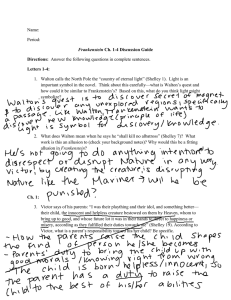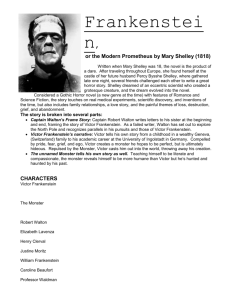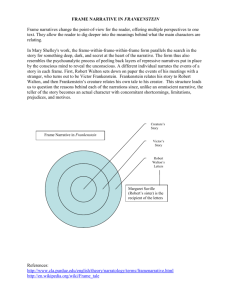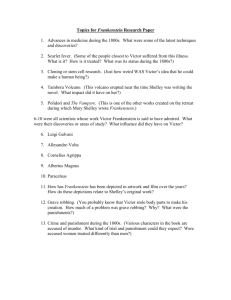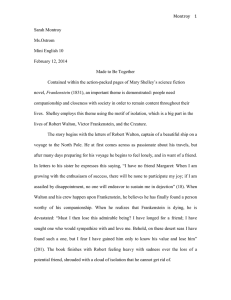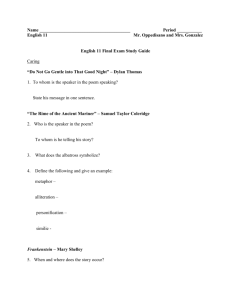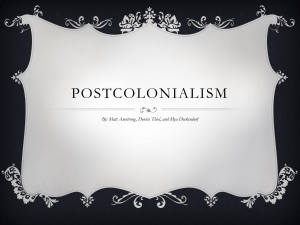Frankenstein Notes
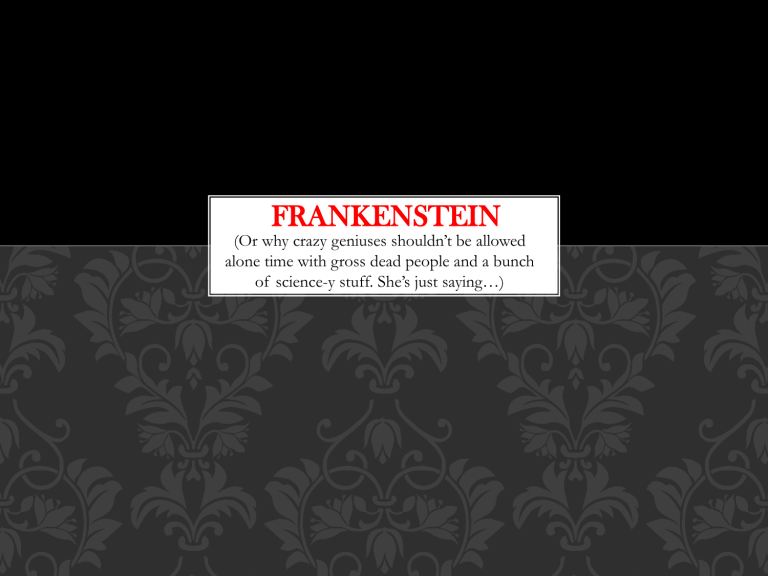
FRANKENSTEIN
(Or why crazy geniuses shouldn’t be allowed alone time with gross dead people and a bunch of science-y stuff. She’s just saying…)
BACKGROUND
• Mary Shelley developed the idea for Frankenstein while participating in a scary story contest with fellow writers.
• As a Romantic, Shelley believed in the restorative power of nature, as well as a distrust of science. Frankenstein portrays both the dangers of pushing science too far and the positive effects of spending time in nature.
• Shelley writes in the Romantic Gothic style, which features 1) isolated or ominous locales; 2) large, rambling structures; 3) implied danger to isolated or vulnerable characters; and 4) horrific distress or menace, such as mysterious disappearances or deaths, supernatural manifestations, omens, unexplained events, or an atmosphere of terror and suspense
MAJOR THEMES OF
FRANKENSTEIN
The dangers of scientific exploration
The repercussions of taking science too far
The horrible consequences of “playing God”
Emotion over reason
THE ROMANTICS OF
FRANKENSTEIN
Walton feels alone on his ship because none of his crew is on his intellectual level.
When the ship rescues Victor, Walton is finally able to have someone to talk to about research.
The Romantic Period includes a shift toward nature over science; Victor’s desire to push the boundaries of science link back to the use of science to understand the mysteries of the universe during the Restoration Period. The repercussions of his actions show the dangers of pushing science too far, even if it results in advancements.
Nature has restorative powers; Victor often goes into nature to cope with his extreme anxiety and mood swings.
FRAME STORY
Frankenstein has a Frame Story
A Frame Story is a story that contains another story
Examples: The Canterbury Tales (we read one!), Slumdog Millionaire,
Aladdin, Titanic (with Leo), The Princess Bride, How I Met Your Mother
Usually, the main story is the one contained within the frame
Frankenstein begins with the story of Robert Walton and his quest for scientific exploration
Walton and his ship crew rescue Victor Frankenstein, who tells Walton the story of his monster
Once he is on board the ship, Victor decides to tell Walton the story of his creation of the monster, hoping to dissuade Walton from continuing to push scientific boundaries.
NOTABLE CHARACTERS
Robert Walton: Tells our frame story; Walton is on a scientific journey to the far north. While he begins the novel pushing scientific boundaries, he later reconsiders and accepts the need for boundaries.
Victor Frankenstein: Our protagonist, whose obsession with science leads to the creation of a monster. Victor does not recognize the need for boundaries on scientific exploration, leading to his decision to animate his monster.
Henry Clerval: Victor’s BFF who tries to get him to do what’s best
The Creature: Frankenstein’s monster, which is pieced together from corpses and brought to life through Victor’s knowledge of science
Elizabeth Lavenza: Victor’s cousin and his betrothed (love); Elizabeth embodies the emotion and humanity that Victor lacks.
Caroline: Victor’s mother, who sparks his ambition to succeed in his scientific goals
THE CREATURE’S REVENGE
• The creature’s revenge begins with the murder of Victor’s angelic brother,
William.
• William is young and cherished by his family, so his loss greatly hurts Victor and draws him back to his hometown.
• Family friend Justine Moritz, who has lived off and on with the Frankenstein family and has even helped care for their dying mother, is blamed for the murder because of circumstantial evidence.
• Even though Victor knows that Justine is innocent and his creature is the true killer, he remains silent.
• Justine’s conviction for murder shows that Victor refuses to take responsibility because he knows that he is to blame for what happened but doesn’t speak on
Justine’s behalf.
• Victor feels guilty for creating the creature who killed his brother, for allowing
Justine to be convicted without speaking on her behalf, and for ignoring his family, which has left them vulnerable to the creature.
THE CREATURE’S REQUEST
• The creature wants Victor to create a new monster – a female companion for him.
• The creature has realized that he will never be loved by humans because of his hideous appearance and has accepted that he is seen as a monster.
• Because he is hideous and lonely, the creature wants a female who is just as ugly so that he won’t be alone.

